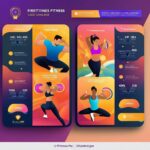https://weightliftingforpower.com/best-online-workout-programs-for-beginners/
Best Online Workout Programs For Beginners in 2024
Beginning an exercise routine may seem intimidating, but taking that first step can transform your life. With a clear plan, you’ll discover the confidence and motivation you need to succeed. But here’s the thing: getting started is a big win. Consistent exercise is like a magic bullet for your health. It boosts your mood, enhances energy, and makes everyday activities easier. Plus, the added physical benefits come with sticking to a routine.

Online workout programs have revolutionized the fitness world, especially for beginners. They offer unparalleled flexibility and convenience—you can work out anytime, anywhere, putting you in the driver’s seat of your fitness journey. Plus, there’s no need for pricey gym memberships or equipment—a definite bonus if you’re starting.
It’s crucial to find programs that are genuinely beginner-friendly. These workouts feature straightforward instructions and attainable goals, making it easy for everyone to succeed. It’s not just about the content, though. The programs must encourage and motivate you, especially on those tough days when you’re struggling to get started. A beginner-friendly program steadily builds your confidence and fitness level without overwhelming you.
Understanding the basics of workout program jargon is critical. Terms like “high-intensity interval training” (HIIT) and “circuit-based workouts” frequently appear for good reason. These methods are highly effective for maximizing your fitness and achieving quick results. Although they might initially seem intimidating, these structured exercise approaches adapt to anyone, no matter their fitness level. As a beginner, look for programs that explain these terms clearly, helping you get comfortable and confident right from the start.
Top Features to Look For in an Online Workout Program
Finding the right online workout program means examining a few key features. One of the top things to seek out is personalization. Only some people want to lift the same weights or run the same distance. Great programs often tailor their workouts to match your fitness level, helping you scale up as you grow stronger.

Another vital aspect is instructional quality. Clear, easy-to-follow instructions in video form can make all the difference, especially if you’re new to coursing. Find classes taught by skilled instructors who offer advice on correct techniques and forms to help lower your chances of injury.
Progress tracking and community support also play a huge role. Many online platforms include features to monitor your progress over time—a great motivator to keep going. Plus, having a community can provide that extra push you might need. Engaging with others can help you stay committed and find motivation when you need it most.
Cost is another consideration. There are free and paid options, each with its benefits. Free programs are a great starting point if you’re testing the waters, but paid programs might offer more tailored content and features. The monthly fees for paid programs vary between $10 and $30, based on the platform and available features. Assessing the benefits and drawbacks in light of your needs and budget is crucial for making the best decision. Evaluating the advantages and disadvantages in light of your needs and budget is essential for making the best decision.
Reviewing Popular Online Workout Programs for Beginners
With so many options available, choosing a workout program can feel overwhelming. Nike Training Club is one of the top picks, especially for its wide array of free workouts. The app offers everything from strength training to yoga, making it approachable for beginners. Plus, the guidance is solid, helping you learn as you progress.
Peloton Digital is another platform that offers more than just workouts. It’s a community that provides versatility and variety. It’s more than just cycling; you’ll find running, strength, and classes. The community aspect is vital here, offering a sense of belonging and encouragement, which can be great for keeping you on track and making you feel part of a team.
Alo Moves can be a fantastic choice for those who prefer yoga and mindfulness. The sessions are well-suited for different skill levels and focus on physical wellness and mental clarity. Starting with simple routines can ease you into regular practice.
These workouts are designed for efficiency, making them the perfect way to incorporate fitness into your busy lifestyle effortlessly. With a focus on blendable routines, you can easily mix and match to target your daily goals.
Establishing achievable fitness objectives can significantly boost your motivation as you embark on a new exercise routine. Start with small, achievable targets that align with your current fitness level and gradually aim higher as you progress.

Creating a dedicated workout space at home, no matter how small can help you get into the right mindset. Even a corner of a room with enough space to stretch out can become your workout zone.
Motivation can sometimes waver, but incorporating variety can keep things fresh and exciting. Try mixing different workouts, like combining yoga with strength training or cardio. The change not only keeps you engaged but benefits your overall fitness.
Listening to your body is crucial. Rest when you need to, and don’t push through pain—exercise should challenge you, not harm you. Safety precautions, like warming up before and cooling down afterward, are vital to preventing injuries and ensuring a sustainable fitness journey. Remember, your safety and well-being are paramount.

https://www.wealthyaffiliate.com?a_aid=352a86b2















 “Exploring diverse terrains calls for the right footwear for the job. Each landscape demands a specific type of shoe to conquer its challenges. Without the right footwear, you could be risking discomfort and potential injury. Investing in the correct shoes for different terrains can enhance your outdoor experience and help ensure your safety and enjoyment.”If you’re sticking to city pavements, a pair of lightweight walking shoes with a flexible sole is a sound choice. Trails with uneven surfaces or rocky paths require a shoe with more grip and ankle support. Consider how and where you’ll be walking the most to make the right choice.
“Exploring diverse terrains calls for the right footwear for the job. Each landscape demands a specific type of shoe to conquer its challenges. Without the right footwear, you could be risking discomfort and potential injury. Investing in the correct shoes for different terrains can enhance your outdoor experience and help ensure your safety and enjoyment.”If you’re sticking to city pavements, a pair of lightweight walking shoes with a flexible sole is a sound choice. Trails with uneven surfaces or rocky paths require a shoe with more grip and ankle support. Consider how and where you’ll be walking the most to make the right choice.
